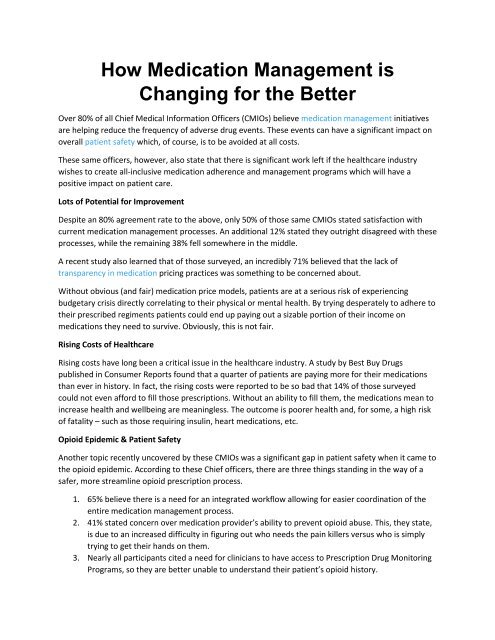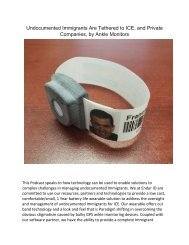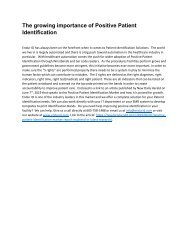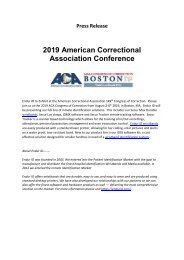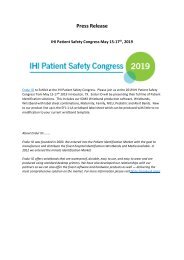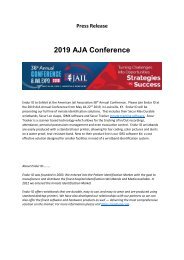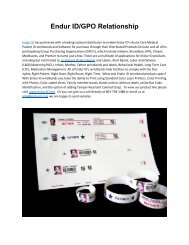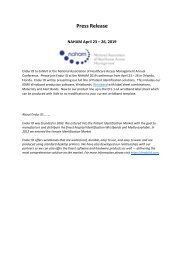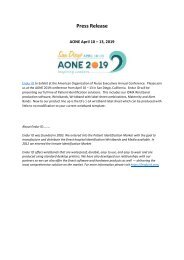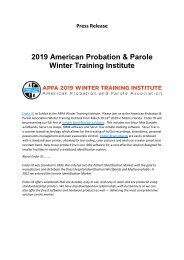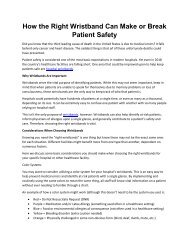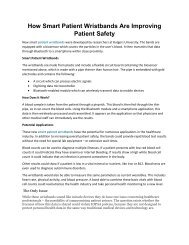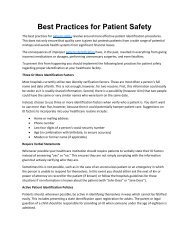How Medication Management is Changing for the Better
Over 80% of all Chief Medical Information Officers (CMIOs) believe medication management initiatives are helping reduce the frequency of adverse drug events. These events can have a significant impact on overall patient safety which, of course, is to be avoided at all costs. Visit: http://endurid.com
Over 80% of all Chief Medical Information Officers (CMIOs) believe medication management initiatives are helping reduce the frequency of adverse drug events. These events can have a significant impact on overall patient safety which, of course, is to be avoided at all costs. Visit: http://endurid.com
Create successful ePaper yourself
Turn your PDF publications into a flip-book with our unique Google optimized e-Paper software.
<strong>How</strong> <strong>Medication</strong> <strong>Management</strong> <strong>is</strong><br />
<strong>Changing</strong> <strong>for</strong> <strong>the</strong> <strong>Better</strong><br />
Over 80% of all Chief Medical In<strong>for</strong>mation Officers (CMIOs) believe medication management initiatives<br />
are helping reduce <strong>the</strong> frequency of adverse drug events. These events can have a significant impact on<br />
overall patient safety which, of course, <strong>is</strong> to be avoided at all costs.<br />
These same officers, however, also state that <strong>the</strong>re <strong>is</strong> significant work left if <strong>the</strong> healthcare industry<br />
w<strong>is</strong>hes to create all-inclusive medication adherence and management programs which will have a<br />
positive impact on patient care.<br />
Lots of Potential <strong>for</strong> Improvement<br />
Despite an 80% agreement rate to <strong>the</strong> above, only 50% of those same CMIOs stated sat<strong>is</strong>faction with<br />
current medication management processes. An additional 12% stated <strong>the</strong>y outright d<strong>is</strong>agreed with <strong>the</strong>se<br />
processes, while <strong>the</strong> remaining 38% fell somewhere in <strong>the</strong> middle.<br />
A recent study also learned that of those surveyed, an incredibly 71% believed that <strong>the</strong> lack of<br />
transparency in medication pricing practices was something to be concerned about.<br />
Without obvious (and fair) medication price models, patients are at a serious r<strong>is</strong>k of experiencing<br />
budgetary cr<strong>is</strong><strong>is</strong> directly correlating to <strong>the</strong>ir physical or mental health. By trying desperately to adhere to<br />
<strong>the</strong>ir prescribed regiments patients could end up paying out a sizable portion of <strong>the</strong>ir income on<br />
medications <strong>the</strong>y need to survive. Obviously, th<strong>is</strong> <strong>is</strong> not fair.<br />
R<strong>is</strong>ing Costs of Healthcare<br />
R<strong>is</strong>ing costs have long been a critical <strong>is</strong>sue in <strong>the</strong> healthcare industry. A study by Best Buy Drugs<br />
publ<strong>is</strong>hed in Consumer Reports found that a quarter of patients are paying more <strong>for</strong> <strong>the</strong>ir medications<br />
than ever in h<strong>is</strong>tory. In fact, <strong>the</strong> r<strong>is</strong>ing costs were reported to be so bad that 14% of those surveyed<br />
could not even af<strong>for</strong>d to fill those prescriptions. Without an ability to fill <strong>the</strong>m, <strong>the</strong> medications mean to<br />
increase health and wellbeing are meaningless. The outcome <strong>is</strong> poorer health and, <strong>for</strong> some, a high r<strong>is</strong>k<br />
of fatality – such as those requiring insulin, heart medications, etc.<br />
Opioid Epidemic & Patient Safety<br />
Ano<strong>the</strong>r topic recently uncovered by <strong>the</strong>se CMIOs was a significant gap in patient safety when it came to<br />
<strong>the</strong> opioid epidemic. According to <strong>the</strong>se Chief officers, <strong>the</strong>re are three things standing in <strong>the</strong> way of a<br />
safer, more streamline opioid prescription process.<br />
1. 65% believe <strong>the</strong>re <strong>is</strong> a need <strong>for</strong> an integrated workflow allowing <strong>for</strong> easier coordination of <strong>the</strong><br />
entire medication management process.<br />
2. 41% stated concern over medication provider’s ability to prevent opioid abuse. Th<strong>is</strong>, <strong>the</strong>y state,<br />
<strong>is</strong> due to an increased difficulty in figuring out who needs <strong>the</strong> pain killers versus who <strong>is</strong> simply<br />
trying to get <strong>the</strong>ir hands on <strong>the</strong>m.<br />
3. Nearly all participants cited a need <strong>for</strong> clinicians to have access to Prescription Drug Monitoring<br />
Programs, so <strong>the</strong>y are better unable to understand <strong>the</strong>ir patient’s opioid h<strong>is</strong>tory.
Overview<br />
<strong>Medication</strong> management has proved to be highly useful in increasing patient safety. There <strong>is</strong><br />
considerable room <strong>for</strong> th<strong>is</strong> to still be improved upon, however. The above-l<strong>is</strong>ted results indicate that,<br />
although some areas are falling under great compliance to current federal regulations, o<strong>the</strong>r areas still<br />
fall frighteningly short.


